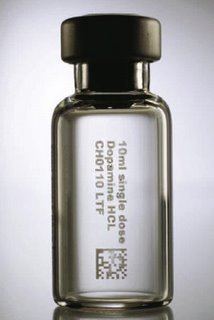It is estimated that 7-8% of the drugs world wide are counterfeit and the value of this will reach $75b by 2010. RFID has been hyped as the answer to this problem.
 Until RFID tags are added to all drugs, there's another way to stop counterfeiting, the 2D code.
Until RFID tags are added to all drugs, there's another way to stop counterfeiting, the 2D code.The 2D code and RFID tag are just two examples of a physical world hyperlink (PWH)
ATS Automation Tooling has partnered with Tesa to launch a new marking technology to combat counterfeiting of glass drug products.
The Validate system uses ATS's automated laser system to permanently mark product and supply chain information, including text, logos, lines and 2D barcode matrixes, into the glass packaging of a drug, using transfer film formulated by tape and label specialists, Tesa.
This method is non-ablating, the end result is very legible and can easily be read by traditional bar code readers.
Unlike RFID, the 2D barcode matrix can be read by barcode readers that are already widely available in the supply chain, thus bringing additional cost savings.
However, don't sell the RFID tag short.
SAP just recently announced an application that can read an RFID tag using a mobile phone.
SAP Corporate Research started work in 1998 to generate SAP applications that could be deployed on intelligent devices such as Nokia mobile phones.

Pharmacists can compare the Electronic Product Code (EPC) data encoded in a product’s RFID tag to the manufacturer’s records. This application now running on the intelligent device (such as an RFID-enabled smart phone) can read RFID signals from tags using near-field communication.
Who is developing an RFID "browser" for the mobile phone?
Both SAP and Nokia want users to take advantage of the latest developing technologies to access enterprise applications on mobile phones.
When you accept that every physical item will have a physical world hyperlink, you will then see how Google can connect the physical world
No comments:
Post a Comment